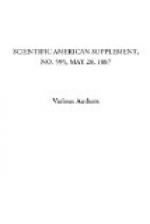The rainfall in Bombay is from 80 in. to 100 in. per annum, and throughout India may be taken as from 50 in. to 130 in., varying, as is the general rule, in direct ratio with the altitude, and limited to a few weeks in the year. Notwithstanding this, there still exist in the Madras Presidency a not inconsiderable number of ancient bunds which serve their intended purpose at the present day as well as ever. Slight mistakes did occasionally occur, as they ever will till no more dams are wanted, as is proved by the remains of some works in Ceylon, where the failure was evidently due to error, possibly due to the instruments being out of adjustment, as their base is at a higher level than the bed of the stream at the point where water from the latter was to be diverted to afford the supply.
Among the most remarkable of these ancient works is the Horra-Bera tank, the bund of which is between three and four miles in length and from 50 to 70 ft. in height, and although now in ruins would formerly impound a reservoir lake of from eight to ten miles long and three to four miles broad. There is also the Kala-Weva tank, with a bund of twelve miles in length, which would, if perfect, create a lake of forty miles in circumference. Both of these ruined works are situated in Ceylon. The third embankment of a similar character is that of the Cummum tank, situated in the Madras Presidency, and which, though ranking among the earliest works of Hindoo history, is still in such a condition as to fulfill its original intention. The area of the reservoir is about fifteen square miles, the dam about 102 ft. high, with a breadth at the crest of 76 ft., and of the section shown in the diagram.
The by-wash is cut in the solid rock altogether clear of the dam; the outlet culverts, however, are carried under the bank. We will now consider generally the methods employed in determining the site, dimensions, and methods of construction of reservoir dams adapted to the varying circumstances and requirements of modern times, with a few references to some of the more important works constructed or in progress, which it will be endeavored to make as concise and burdened with as few enumerations of dimensions as possible.
The amount of the supply of water required, and the purposes to which it is to be applied, whether for household, manufacturing, or irrigation uses, are among the first considerations affecting the choice of the site of the reservoir, and is governed by the amount of rainfall available, after deducting for evaporation and absorption, and the nature of the surface soil and vegetation. The next important point is to determine the position of the dam, having regard to the suitability of the ground for affording a good foundation and the impoundment of the requisite body of water with the least outlay on embankment works.




